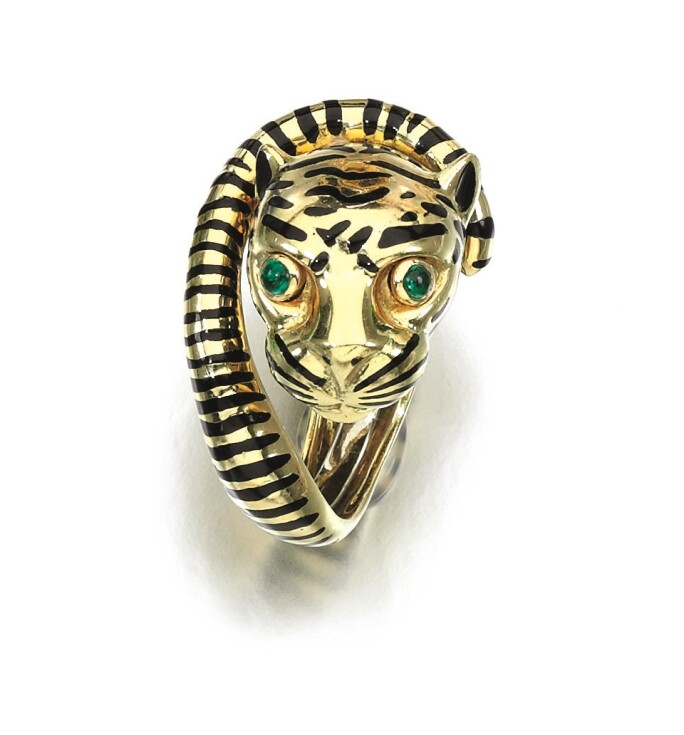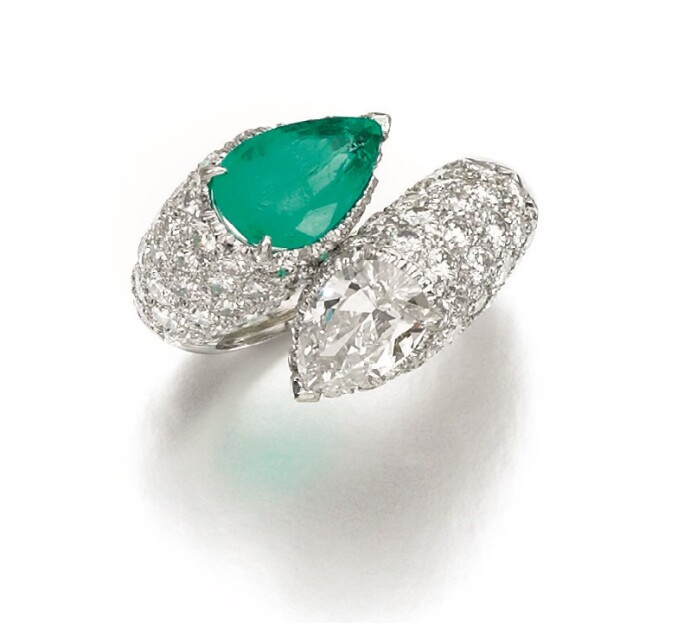A mong the many jewelry houses that have shaped modern jewelry over the course of the 20th century, only a handful can truly lay claim to an aesthetic style that is all theirs. Of these, even fewer have been able to stay as consistently faithful to that signature style over the decades. David Webb is one of these.
The enduring image of David Webb is intrinsically tied to his ascent to fame amidst the glamour of early 1960’s America, but of course, the story started much earlier than that. David Webb was born in 1925 in Asheville, North Carolina, and got his start as an apprentice in a silversmith’s shop belonging to his uncle, before moving to New York where he worked repairing jewelry in Greenwich Village.
Estimate £8,000-12,000.
It was not long before Webb’s natural charm and talent brought him to the attention of New York’s social elite and, with the backing of the wealthy patron Antoinette Quilleret, he was eventually able to open his own shop in 1945. His fledgling business quickly met with enough success that he was able to buy out Quilleret shortly afterwards, establishing David Webb Inc. in 1948.
Estimate £5,500-9,000.
Webb’s self-taught style brimmed with ideas gleaned from years spent poring over ancient jewels from Greece, Mesopotamia, and Central and South America, as well as traditional jewelry styles from China and India. Of course, design trends closer to home also had their part to play in his development. The trajectory of American and European jewelry over his formative years can be broadly described as a swing away from the abstract geometry of Art Deco towards more exuberant, figurative themes from the natural world. This movement was championed by such industry titans as Cartier, where the influential partnership of creative director Jeanne Toussaint and designer Peter Lemarchand resulted in all manner of animal motifs, culminating in Cartier’s famed ‘Big Cat’ jewels of the late 1940s onwards. The influence was inescapable - in Webb’s own words, ‘everything was born from the influence of Toussaint, naturally she inspired all of us’.
Webb’s jewels were natural spiritual successors to both Cartier’s figurative jewels, and their earlier Indian-influenced ‘Tutti Frutti’ style of the mid 1920’s, but it was Webb’s own visionary spin on these motifs that propelled his firm to success.
Estimate £2,600-4,500.
His designs made an impression on some of the most influential jewelry collectors of the era, perhaps most prominently Jacqueline Kennedy Onassis (1929-1994). His status as the pre-eminent American jeweler was astutely recognised by the First Lady, who commissioned him to create a series of paperweights featuring a variety of American minerals to be presented to visiting heads of state. King Hassan of Morocco, for example, was presented with a gold figure of an American Eagle inset with an American topaz on a state visit in March 1963.
Estimate £4,500-7,000.
Another piece, that remained in the collection of Jacqueline Kennedy Onassis and was sold at Sotheby’s in 1996, particularly embodies the warmth of Webb’s relationship with his glamorous patron. It was a Cellini-esque coral paperweight. The buff-coloured coral was of sentimental significance – it had been originally presented to President Kennedy as a gift, as it originated from Kasolo Island in the Solomon Islands, where he had been shipwrecked in 1943. Webb was entrusted by Jacqueline Kennedy, to rework her late husband’s coral in 1966, using it to form the fish tail of typically imaginative mythical sea-lion, cast in gold, which he rested upon a larger piece of coral amongst a bed of golden crystals to form the paperweight.
Estimate £5,500-9,000.
Webb’s animal-themed jewels were a particular favourite among a wealth of famous clientele, for example, the Duke of Windsor, who bought an enamelled frog bangle as a surprise gift for his wife in March 1964. The piece was undoubtedly well received, as Webb is said to have followed up the purchase with a matching pair of ear clips, which he gave as a gift directly to the Duchess herself.
He also found a following in Hollywood: his chimera bangles, themselves a vigorous reinvention of similar traditional Indian jewelry designs and later versions by Cartier, joined the menagerie of Elizabeth Taylor, and a number of his other striking designs also found their way into the collections of stars such as Ava Gardner, Lana Turner and Merle Oberon. The ultimate endorsement came from the supreme arbiter of forward-thinking fashion of the era – the eccentric editor of Harper’s Bazaar Diana Vreeland, who treasured a dramatically striped enamel bangle modelled as a zebra, Webb’s own adopted symbol.
Estimate £3,500-7,000.
This remarkable career was tragically cut short – David Webb died of pancreatic cancer in 1975, at the age of just 50. Despite this devastating loss, the company has continued, producing jewels remarkably in keeping with the spirit, imagination and quality that defined Webb’s enduring style, still from the workshop above his flagship store overlooking the bustle of New York’s Madison Avenue.
A collection of jewels by David Webb appears in our Fine Jewels sale on 11 December giving London the rare chance to admire the remarkable aesthetic of this seminal American jeweller first hand. Whether in marbled azurmalachite, nebulous formations of rock crystal or richly carved rubies, sapphires and emeralds, this collection is testament to Webb’s ability to create drama and sheer visual impact even in his more abstract jewels. With his love of enamelling, intricately carved stones, yellow gold and bright chromatic combinations, Webb’s style is larger-than-life, whimsical, sensual, and absolutely unmistakable.








